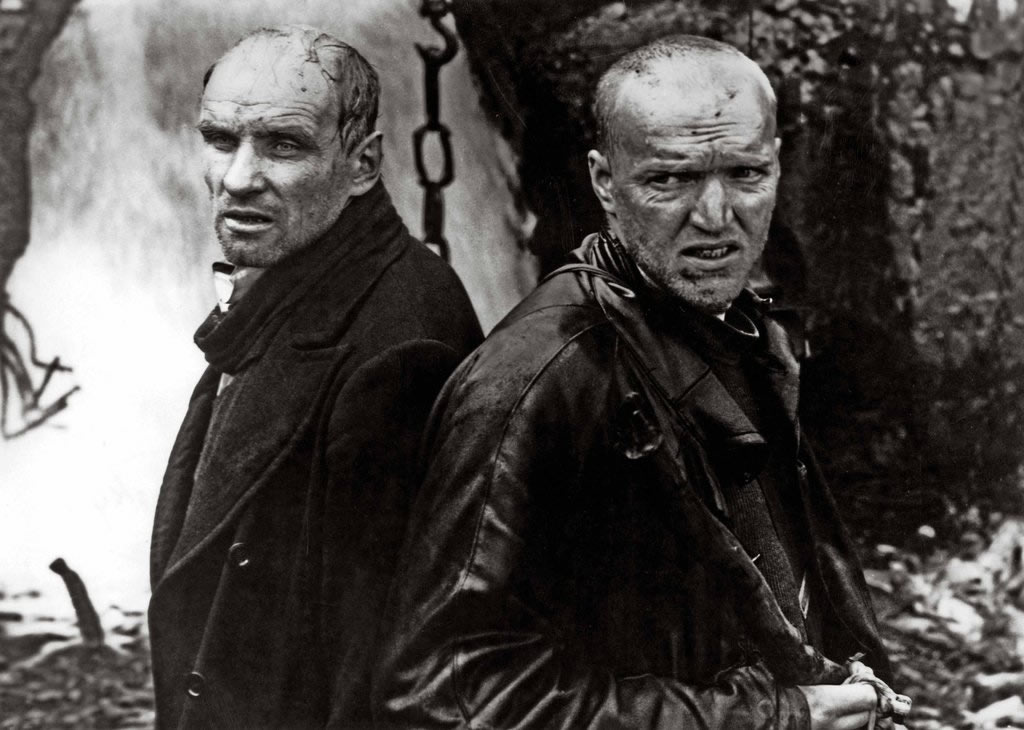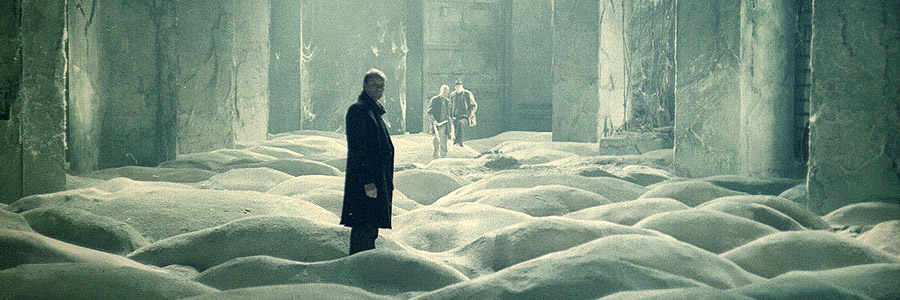There’s a point early on in Andrei Tarkovsky’s STALKER where the Stalker, the Professor, and the Writer have snuck past a military blockade, dodged bullets and ridden a railway work car for a few silent minutes of screen time. The film switches from sepia to color - they have entered The Zone, a mysterious alien-touched segment of the world. “We are home” Stalker says. “It is so quiet out here, it is the quietest place in the world.”

The Zone sequences were filmed in Estonia, where my parents’ families lived before WW2 drove them to America and the Iron Curtain walled them off from their families and homeland. In the film we see it in color - idyllic but also destroyed. Rotting tanks lie strewn across a field. It reminds me a little of my first trips there after independence, mostly because of the strong verdant color, the open and overgrown fields, and the rotting stone and wood construction.
Something is weird about The Zone. We don’t know what, but the Stalker moves carefully and angrily addresses any breaches of protocol. The danger feels intangible and omnipresent. Apparently Tarkovsky was inspired by a nuclear accident near Chelyabinsk in 1957. The isolated and abandoned zone is reminiscent of Chernobyl, which happened in 1986. The radiation allegory maps well to more recent disasters as in Fukushima.
One of the most horrific things in radiation stories to me is the point where the very high-tech system breaks and it shows how completely unprepared humans are to deal with the consequences. It seems there’s always a terrible DIY component. In Japan “jarringly primitive measures” (newspaper and sawdust) were used to seal radioactive leaks. In the Soviet K-19 disaster, sailors needed to jury-rig a cooling device while working next to an exposed reactor. Here, the group ties strips of cloth to iron nuts which are thrown ahead to mark the path.
There’s a strong sense that any missteps will be fatal - a great result given a movie mostly comprised of three men walking through a series of ruins. The dread does not lie in whether something will come out and attack these men - it’s more of a sense that this space is perverted in a way that is indecipherable to most people. Those who can navigate are labeled Stalkers, guides into the heart of The Zone.

I think the whole Eastern Bloc has a respect for the crafty, trickster type. It seems that at least half the Estonian folk tales I’ve read involve a farmer outwitting the Devil through some clever machinations. These tricksters are the people who tie a rag to a nut and throw it ahead of them to see if the next ten steps will kill them. It’s the opposite of entitlement. Instead of being defined by want for or access to special things, this is a mindset which says “this is what we have, what can we do with it”.
It is, unfortunately, a terrible mindset to have when resources are abundant - one tends to hoard every last scrap, or to spend a disproportionate amount of time and energy on small problems.
But it is the right mindset for three men to sneak a gallon of petrol past armed guards, use it to fuel transport into a deadly alien Zone, and then slowly amble over an alien wasteland which will probably kill them. All this in service of searching for a Room, which they believe will make their deepest desires come true.
It it real? The Writer briefly mulls it:
"The world is absolutely dull, and that is why there’s neither telepathy, nor ghosts, nor flying saucers ... and there cannot be anything of the kind. Iron laws control the world and it’s intolerably boring. And these laws, alas, cannot be broken. They’re not able to."
His companion points out that he claimed The Zone was the product of a supreme civilization. “That’s probably also boring. The same sort of laws, triangles, and absolutely no house-spirits and, of course, no God.” Ultimately: “God is the same triangle”.
We get the sense that he doesn’t want to believe it. He would like to be wrong.
The Professor reveals his fears about the Room upon its threshold:
"Can you imagine what happens if everybody comes to believe in this very Room? And when all of them will rush in here? And it’s a question of time! If not today, so tomorrow! And not in tens, but in thousands! All those emperors, great inquisitors, Fuhrers of all kinds, that didn’t go through. Such benefactors of the human race! And not after the money, not after the inspiration, but to remake the world!".
He wants to destroy it in case it could possibly be real.
The final, most grounded tension of the movie lies at the decision of whether to enter the room. The Stalker is revealed as the cleric of the group. His willingness to lead people here is not so much for gain. He has suffered the toll that The Zone has taken from him and his family (as we see in the end) as an act of faith:
"If they only imagined how tired I am! Only God knows! And they call themselves intelligentsia. Those writers! Scientists! They do not believe in anything. That their ... organ with which they believe has atrophied! My God, what kind of people they are... their eyes are empty."
(Was this appeal to religion very subversive in the Soviet Union at the time? I can’t even begin to contextualize it)
In Stalker, the average shot length is 88 seconds. The final shot in The Zone feels long, even for such a soporific movie. Bolero plays. The Zone loses color. Tarkovsky showed a bit of resourcefulness of his own to get this - he built a very long film processing vat with different temperatures, allowing him to change the color of a single piece of film. It might very well be that no other strip of film was ever treated this way.
Tarkovsky referred to his style “sculpting in time”. The opening shot at the bar when the characters meet is an agonizingly slow push into the scene. You almost don’t notice it until you realize that you started the scene in the doorway and wind up standing at their table. Tarkovsky’s response to criticism of the pace of the film was “the film needs to be slower and duller at the start so that the viewers who walked into the wrong theatre have time to leave before the main action starts.” But the entire movie is like that, slow, purposeful, patient. The controlled movements are like what Wes Anderson does, but contextualized not in preciousness but agony.
During the most significant dream sequence we get a vertical tracking shot of a river with religious iconography, money, guns and bullets in it. Everything is buried in the water. A syringe, a plate, a mirror, an aquarium with fishes, a religious icon, coins, gauze, a gun, an industrial spring, a page from a calendar, metal parts, wire, Stalker’s hand. The river is covered with thick yellowish foam. The wind lifts flecks of foam from the river and floats them over rocks and stones. Stalker is lying down next to the water, and his wife narrates:
"And there an immense earthquake took place, and the Sun became dark as sack cloth, and the Moon was like covered with blood... And the stars of the heaven fell to the ground as if a fig-tree, shaken by a great wind, let its unripe figs fall down. And the sky hid itself, rolled up as a scroll; and various hills and isles moved from their places... And the kings on earth, and the dignitaries, and the rich, and leaders of the thousands, and the powerful, and all the free hid themselves in the caves and mountain-gorges and they told the mountains and the rocks: fall on us and hide us from the face of the One sitting on the throne and from the wrath of the Lamb; for the great day of His wrath is come, and who can withstand it?"
When the group makes it into the building which houses the Room, we get another horrific sculpture in time. The camera pushes in. What resolves is first a striking, immaculate piece of red hair - a wig. The shapes around it resolve to be clearer in time. It’s two skeletons - one wearing the artificial wig - arms around each other.
The Zone is, literally, poison. From the sound designer, Vladimir Sharun:
"We were shooting near Tallinn in the area around the small river Jägala with a half-functioning hydroelectric station. Up the river was a chemical plant and it poured out poisonous liquids downstream. There is even this shot in Stalker: snow falling in the summer and white foam floating down the river. In fact it was some horrible poison. Many women in our crew got allergic reactions on their faces. Tarkovsky died from cancer of the right bronchial tube. And Tolya Solonitsyn too. That it was all connected to the location shooting for Stalker became clear to me when Larisa Tarkovskaya died from the same illness in Paris"
Tarkovsky, the actor playing the Writer, and Tarkovsky’s wife all died from cancer resulting from shooting this movie in Estonia, the quietest place in the world.
Comments? If you have feedback, please share it with me on Twitter!